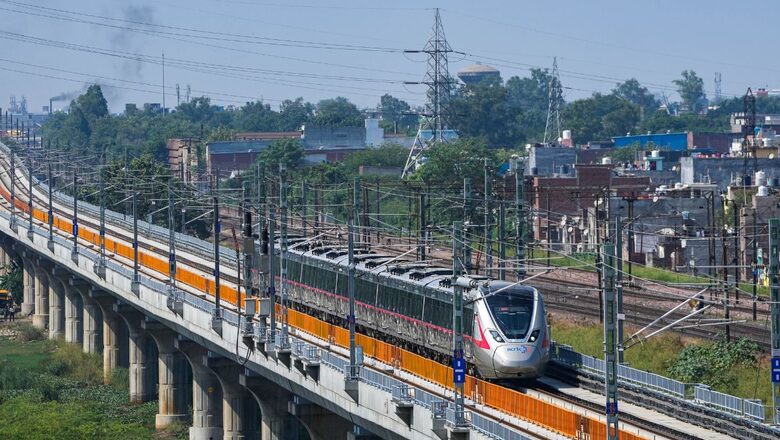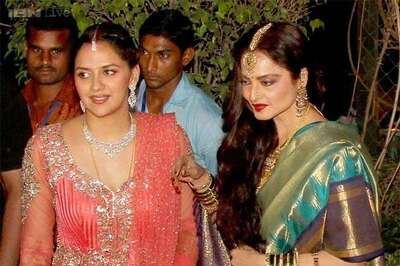
views
Some days are defining moments in the history of a nation. Friday, September 20, was the one for India. In impact, it is akin to the following glorious moments in the history of rail-based transport in India-
- In the 19th century, on April 16, 1853, three locomotives — Sindh, Sultan and Sahib — of the Great Indian Peninsula Railway operated the maiden passenger train in India from Bori Bunder to Thane in one hour and fifteen minutes with 14 carriages and 400 passengers.
- In the last decade of the 20th century, the great Elephant awakening moment for India was when Prime Minister Atal Bihari Vajpayee dedicated the signature rail project 760 km Konkan Railway to the nation, a moment that gave India the courage and conviction “we can do it”.
- In the first decade of the current century, on December 25, 2002, a small stretch of 8.5 km of Delhi Metro was declared open by then Prime Minister Atal Bihari Vajpayee. The moment became a precursor to the ushering of the metro rail revolution in the country which was brought by the same person, E. Sreedharan, who dreamt and delivered the Konkan Railway to clockwise precision. His role in bringing the metro rail revolution to the country gave him the moniker ‘Metro Man of India’.
- Cut to circa 2019, in the second decade of the current century, when on February 15, 2019, Prime Minister Narendra Modi launched the first Vande Bharat train, the first indigenous, semi-high-speed train manufactured by the Integral Coach Factory (ICF) in Chennai, between Delhi and Varanasi.
The Occasion
The occasion that scripted history on October 20, 2023, was the inauguration by Prime Minister Narendra Modi of the 17-km priority section between Sahibabad and Duhai Depot (with five stations- Sahibabad, Ghaziabad, Guldhar, Duhai and Duhai Depot) of Rs 30,000 crore Delhi-Ghaziabad-Meerut RRTS Corridor (rechristened Namo Bharat).
Regular passenger services in the section commence today.
Impact
With a design speed of 180 kmph, Namo Bharat’s foundation stone was laid on March 8, 2019. It will redefine the travel between New Delhi and Meerut by reducing the time to less than one hour. This is what Hardeep Singh Puri, Minister in charge of Urban Affairs, said on ‘X’, formerly known as Twitter, “Indigenously manufactured with a designed speed potential of 180 kmph and operational speed potential of 160 kmph, the fully air-conditioned, safe and comfortable train will take less than an hour to cover 82 km between Delhi and Modipuram in Meerut.”
Puri added further, “Inauguration of the country’s first Regional Rapid Train #NamoBharat between Sahibabad and Duhai Depot by Prime Minister Narendra Modi on 20 October 2023, will mark the beginning of a new era of state-of-the-art ultra-modern urban commute in the country.”
The Context- Fast Urbanising India at the Inflexion Point
The inauguration of a small stretch of the priority corridor Namo Bharat has to be seen through the prism of the big picture of fast-urbanising India and the critical need for the dispersal of urban population from the hub (CBD) to spokes of well-developed satellite cities. And below is the context that makes Namo Bharat the nostrum that the doctor ordered for fast-urbanising India.
The traditional Indian paradigm was ‘India lives in its villages’, so much so that in the first decade of the 21st century, even the website of the Ministry of Urban Development talked of this phrase. Unsurprisingly then, instead of ensuring orderly urban development, for six decades since independence, India followed the path of containment of cities and towns with devastating impact. Contrarily, urbanisation in the country has been changing the face of the nation fast, with the urban population growing from 16.0 crore in 1981 to 21.7 crore in 1991 to 28.5 crore in 2001 and 37.7 crore in 2011, and likely 48 crore in 2021.
Following are the defining traits of Indian urbanisation that makes the arrival of RRTS or Namo Bharat crucial for the nation-
- Recent decades have witnessed a spurt in the rate of growth of the urban population – 36.44 per cent (1981-1991), 31.51 per cent (1991-2001) and 31.8 per cent (2001-2011). This is partly owing to the organic population growth, in part due to the rural-urban migration and the remainder due to the addition of the new areas as ‘urban.’
- Since 1901, the percentage of the urban population as compared to the country’s total population has grown steadily -10.8 per cent in 1901, 17.2 per cent in 1951, 27.8 per cent in 2001, 31.2 per cent in 2011 and 35.7 per cent in 2022.
- India’s urban population in 2020 (48.0 crore) is one and half times the US population (33.2 crore) of 2022, the third most populous country in the world.
- Though cities in the range of 5-10 lakh and one million plus population are emerging as key growth centres, there is a tilt in the centralisation of the urbanisation process around large metropolitan cities, making Indian urbanisation substantially a process of ‘concentrated urbanisation’. This is the inflexion point where Namo Bharat trains have a great role to play.
- India’s demography is at the epoch-making cusp. In 2022, the Chinese population, for the first time since 1961, shrank by 8,50,000 from that of 2021 to be at 1.4118 billion. This means India has dethroned China as the world’s most populous nation. However, July 2023 Ministry of Home data puts India’s population at 139 crore, a tad lower than that of China.
Fast-Paced Population Growth in Cities
Importantly, a large portion of Indian population growth is happening in cities and urbanisation is at the inflexion point. Fast-paced urbanisation can either yield an urbanisation dividend in conjunction with a demographic dividend or can lead to urban chaos. To put the whole context in perspective as per UN-HABITAT World Cities Report (2022), India’s urban population from 48.31 crore in 2020 will be 54.74 crore in 2025, 60.73 crore in 2030, and 67.45 crore in 2035. The UN Populations Prospects also estimates in 2050 “India’s population will be 167 crores, out of which urban population will be 81.4 crores, tantalisingly close to 50 per cent.”
The fast-growing urbanisation in India must be looked at with a nuanced prism.
Firstly, some states have matured urbanisation, few are reaching there, and some states though have lower urbanisation percentages, the actual urban population is high because these are high-population states.
Secondly, the urban population of India in 2035 (67.45 crore) will be close to the total population (68.4 crore) of India in 1981. Likewise, the urban population in 2050 (81.4 crore) will be closer to the country’s 1991 population (84.4 crore). It brings in its train humungous problems that will require the creation of hundreds of new cities including metropolises and at the same time, the creation of new satellite cities to metropolises and upgrading the connectivity of existing and new satellite cities to metropolises with state-of-the-art Namo Bharat train systems.
Urban India – The Defining Problem
To recap for brevity’s sake, the urban population between 1970 and 2020 has more than quadrupled, from 10.9 crore to 48.31 crore. Also, Indian cities comprising barely 3 per cent landmass contribute 63 per cent to the nation’s GDP and by 2035, they will contribute to 75 per cent of the nation’s GDP. And the defining problem of the cities to actualize their growth potential is the urban transport gridlock, a problem whose solution lies in the fast growth of metro rail in cities and towns in tandem with complementary other hierarchy of service.
The Solution
If urban India has to remain and further grow as the growth centre of the country, the bull of the defining problem of urban transport has to be taken by the horns and the following three rail-based solutions have to be integral to it.
One, connecting at least fifty satellite cities with metropolises with the state-of-the-art Namo Bharat RRTS systems by 2047. This means nothing less than 5000 km of Namo Bharat in the time span will do. With the opening of the priority corridor of the Delhi Meerut system, the country has already taken the first baby step in that direction.
Two, the metro rail revolution in India has taken to wings. On October 20, Prime Minister Modi virtually inaugurated the operation of full purple line of Bengaluru Metro with which the Namma Metro length expanded from 69.6 km to 73.8 km, connecting 66 stations. The occasion also marked India having more than 906 km operational metro rail system in the country (this includes the Navi Mumbai Metro that is awaiting inauguration). Early this year, India surpassed South Korea (883 km) as the country with the third-largest metro rail system and in the next two years, it is likely to cross the US (1375 km) to become the second-largest metro rail system in the world. And by 2047, when the country celebrates 100 years of independence, it will have rightly set its eyes on 5000 km operational metro rail in 100 cities in the country.
Three, much delayed Ahmedabad Mumbai High-Speed Line is finally moving ahead at the desired speed for completion. India needs a calibrated approach of constructing at least 10 such systems on or before 2035.
Postscript
The critical problem of urban mobility gridlock in India is exacerbating at a faster pace as compared to the intended solutions being conceived and put in place. Time is running out. It is time for the nation to act purposively at the breakneck speed. So far, we are fighting to solve yesterday’s problem today. The time is ripe now for India to solve tomorrow’s problem today.
Akhileshwar Sahay is a Multi-Disciplinary Thought Leader with Action Bias and an India Based International Impact Consultant. He works as President Advisory Services of the Consulting Company BARSYL. Views expressed in the above piece are personal and solely that of the author. They do not necessarily reflect News18’s views.

















Comments
0 comment